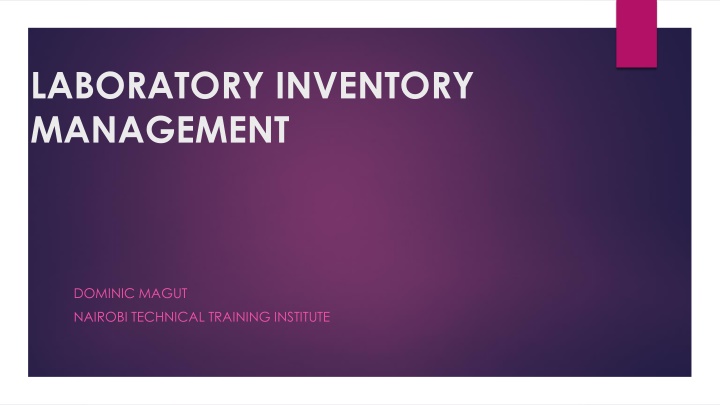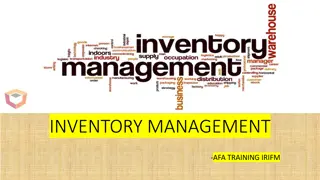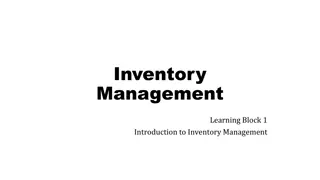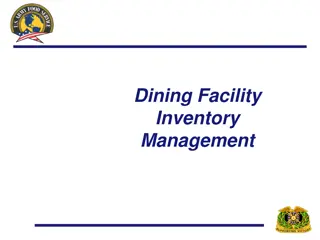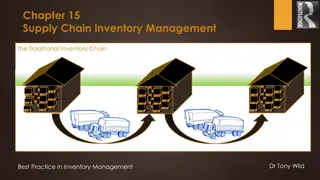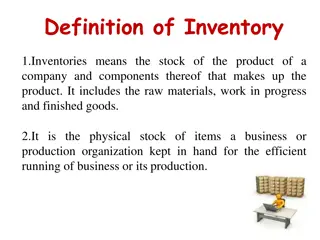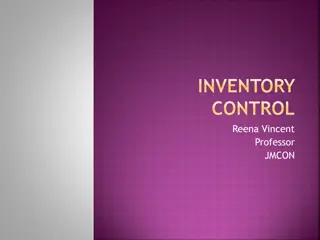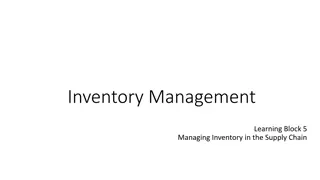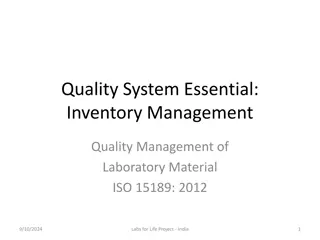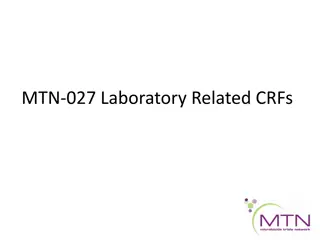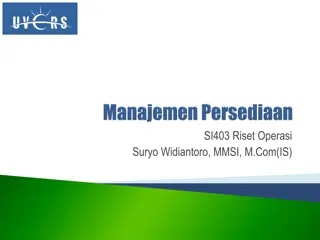Effective Laboratory Inventory Management Practices
Understanding the significance of laboratory inventory management practices is crucial for compliance, efficiency, safety, and cost-effectiveness. This chapter delves into the importance of inventory management, defining key terms, and discussing monitoring, control, and recording of laboratory stock. Learn about requisitioning lab chemicals wisely to prevent wastage and ensure proper storage. Implementing good inventory management practices enhances safety, efficiency, and regulatory compliance in laboratories.
Download Presentation

Please find below an Image/Link to download the presentation.
The content on the website is provided AS IS for your information and personal use only. It may not be sold, licensed, or shared on other websites without obtaining consent from the author.If you encounter any issues during the download, it is possible that the publisher has removed the file from their server.
You are allowed to download the files provided on this website for personal or commercial use, subject to the condition that they are used lawfully. All files are the property of their respective owners.
The content on the website is provided AS IS for your information and personal use only. It may not be sold, licensed, or shared on other websites without obtaining consent from the author.
E N D
Presentation Transcript
LABORATORY INVENTORY MANAGEMENT DOMINIC MAGUT NAIROBI TECHNICAL TRAINING INSTITUTE
OBJECTIVES The objective of this chapter is to give a better understanding of good inventory management practices In this chapter, we will: 1. Describe the importance of good laboratory stock management practices 2. Define the various terms used in inventory management 3. Discuss ways to monitor, control and record laboratory stock
Importance of Lab Inventory Management INTRODUCTION Its absolutely necessary to know exactly what chemical, apparatus and equipment are present in the laboratory and in what quantities. This is what is meant by the term inventory. Inventories serve many valuable purposes such as 1. To comply with the regulatory requirements 2. To increase efficiency in the laboratory 3. It rids the laboratory of acquiring excess or unused chemicals , apparatus and equipments.
Importance Of Lab Inventory Management Cont. 4. It enhances efficient implementation of storage of all remaining chemicals in compatible chemical families and ensures isolation and safety storage particularly of hazardous substances. 5. It helps in creating and maintaining perpetual inventory of all chemical substances. 6. It helps to easily identify substances or items needed for replacement and thus makes easier the requisition process. It also serves as a reminder of items borrowed and owed. 7. It helps to check and confirm substances expired and those that need repair and hence enables proper disposal or maintenance.
Requisitioning Of Lab Chemicals Laboratory chemicals should not be purchased like any other routine supplies i.e. their stock should not be bought in bulk. Because this will result in purchasing of large quantities of chemicals. Most of them may not be required at that particular time, and may end up being stored in lab store rooms that were never designed to handle such quantities and rarely equipped to meet even the minimum safe storage standards such chemicals may end up expiring even before they are used, It is in fact wisdom to buy smaller quantities since most of them will be used and there will be less hazards associated with their use and storage
Requisitioning Of Lab Chemicals There is great need to recognize the problems created by lumping hazardous chemicals into the buying routine . These will aggravate and perpetuate the problem of storage and will increase wastage. The laboratory staff should adopts laboratory a chemical requisition policy which should be aimed at completely eliminating or reducing the quantity of some substances purchased They should also oversee the requisition process so as to ensure that proper chemicals in proper conditions are bought and stored in proper conditions .
Requisitioning Of Lab Chemicals Laboratory inventory taking is a task that requires teamwork and cooperation between the laboratory staff and the administration Students should not be involved in this process. Each item in the store should be listed by 1. Its name, The approximate size of the container 2. 3. The amount still left in the container Its expiry date. 4. 5. If the shelves are loaded,
Requisitioning Of Lab Chemicals It s also appropriate to isolate and scrutinize the bottles carefully as these will enable you to decide which one should stay and which one should be disposed. Disposal should be in accordance with the properties and regulations concerning that particular substance. Those items which are to remain on the shelf can now be reorganized into their compatible chemical families.
Store and Storekeeping Stores generally include raw materials, work in progress and finished goods. Effective storekeeping and inventory control are indispensable to the control of material cost The chief aim of the stores is to ensure the smooth flow of production without any interruption. Stores should be in direct touch with the user departments in its day-to- day activities. .
Objectives Of Laboratory Store Management 1. To ensure the availability of chemicals and equipment when needed. 2. To reduce the cost of storage as much as possible by avoiding deterioration and wastages . 3. To maintain accurate records and provide management data. 4. To repair and maintain laboratory apparatus and items. 5. An ideal store is that one which can meet the following requirements
Objectives Of Laboratory Store Management 6. It must economically provide its services in a manner that it will economize funds allocated to it. 7. It should simplify the problems encountered in classification and identification of chemicals , apparatus and equipment s . 8. It must allow continuously flow of materials in and out of the laboratory so that stock balances are adequate to support the current rate of consumption by the laboratory . 9. Store management must adopt an efficient and reliable system of receiving or giving out all materials , equipment and apparatus.
Over Stocking Over lumping hazardous chemicals into the buying routine will aggravate and perpetuate the problem of storage and will increase wastage . The laboratory staff should adopts laboratory a chemical requisition policy which should be aimed at completely eliminating or reducing the quantity of some substances purchased They must also oversee the requisition process so as to ensure that proper chemicals in proper conditions are bought and stored in proper conditions .
Purpose of Storekeeping 1. Storekeeping helps to examine carefully all goods and materials on receipts. 2. It is essential to arrange for a systematic and efficient storing of materials. 3. Storekeeping ensure accurate and prompt distribution of materials to user departments as per issue requisition note. 4. It is essential because stores often equated directly with money, as capital is blocked in inventories.
Functions of The Storekeeper The storekeeper holds the responsible position in the organization of the stores department. He must receive raw materials, components, tools, equipment and other items and account for them properly. He must provide adequate and proper storage and preservation to the various items. He must check, and provide proper classification and codification of materials. Issue the materials as per material issue requisition duly signed by an authorized person. 1. 2. 3. 4.
Functions of The Storekeeper 5. He has to take steps to prevent leakage, theft, wastage and deterioration. 6. He must ensure good storekeeping. 7. He should not permit any person without authorization. 8. He should maintain proper records in order to know desired quantities available. 9. He must provide adequate information to the top executives for verifications and effective decision making.
TYPES OF STORES The types of stores depend on the size, types and policy of the organization. Organization of stores varies from concern to concern. As per the requirement of the firm the stores organization may be classified into: (a) Centralized Stores. (b) Decentralized Stores. (c) hybrid store, i.e., Centralized Stores with Sub Stores.
Centralized Stores: This system is suitable to small-scale industries where it is desirable to centralize the materials in one department. Under this system, the store room will be most conveniently situated where it is near to all the departments.
Advantages of Centralized Stores 1. Well planned layout of stores. 2. Effective utilization of floor space. 3. Better supervision of stores is possible. 4. Effective material handling is possible. 5. Lot of manual work may be eliminated.
Advantages of Centralized Stores cont. 6. Better control is possible. 7. Less investment is required. 8.Ensures minimum wastages. 9.Facilitates prompt flow of materials. 10.Better forecasting is possible.
Disadvantages of centralized store 1. Increases transportation costs. 2. Delay and inconvenience because of over-crowding of materials. 3. Greater risk of loss in case of fire. 4. Break down in transport will affect continuous flow of production. 5. Increases cost of materials handling.
Decentralized Stores: Under this system each department has its own stores. It is suitable to large concern where there are several departments each using a different type of material from its own stores. In this system all the disadvantages of centralized stores can be eliminated
Hybrid store This system is also termed as Imprest System or stores control. Centralized Stores with Sub Stores is usually adopted in large factories/ organization where departments are situated at a distance from the central stores. In order to minimize the cost of transportation and materials handling, this type of organization would be located nearer to the receiving department. Under this system material receipts are stored in the central stores and issues are made to the sub-stores. To maintain the stocks at the predetermined level, the sub- stores make requisition from the central stores.
Stock Level Material control involves physical control of materials, preservation of stores, minimization of obsolescence and damages through timely disposal and efficient handling. Effective stock control system should ensure the minimization of inventory carrying cost and materials holding cost. Level of stock is the important aspect of inventory control. Stock level may be overstocking or understocking. Overstocking requires large capital with high cost of holding. In the case of understocking, production and overall performance of the concern as a whole will affect. Fixation of stock level is essential to maintain sufficient stock for the smooth flow of production and sales.
Types of Stock levels 1. Maximum Stock Level. 2. Minimum Stock Level. 3. Danger Level. 4. Re-Order Level. 5. Economic Ordering Quantity (EOQ). 6. Average of Stock Level.
Maximum Stock Level: This refers to the maximum stock level beyond which quantity of an item should not be allowed to increase or the maximum quantity of an item can be held in stock at any time. The maximum stock level can be calculated by the following formula : Maximum Stock Level = Re-Order Level + Re-Ordering Quantity (Minimum Consumption x Minimum Re- Ordering Period)
Maximum Stock Level. Cont. The following factors can be considered while fixing the maximum stock levels : 1. Availability of capital. 2. Availability of floor space. 3. Cost of storage. 4. Possibility of fluctuation of prices in raw materials. 5. Cost of insurance.
Maximum Stock Level. Cont. 6. Economic order of quantity 7. Average rate of consumption. 8. Re-order level and lead time. 9. Seasonal nature of supply. 10. Risk of obsolescence, depletion, evaporation etc.
Minimum Stock Level Minimum stock level indicates the minimum quantity of material to be maintained in stock. Accordingly, the minimum quantity of an item should not be allowed to fall. The minimum stock is also known as Safety Stock or Buffer Stock. The following formula is adopted for calculation of minimum stock level : Minimum Stock Level = Re-Order Level - (Normal Consumption x Normal Re-Order Period)
Danger Level: It is the stock level below the Minimum Level. This level indicates the danger point to affect the normal production. When materials reach danger level, necessary steps should be taken to restock the materials. If there is any emergency, special arrangements should be made for fresh issue. Generally this level is fixed above the minimum level but below the reordering level. The formula for determination of danger level is : Danger Level = Average Rate of Consumption x Emergency Supply Time
Re-order Level: Re-order level is also termed as ordering Level. It indicates when to order, i.e., orders for its fresh supplies. This is the stock level between maximum and the minimum stock levels. The re-order stock level is fixed on the basis of economic order quantity, lead time and average rate of consumption. Calculation of re-order level is adopted by the following formula : Re-order Level = Minimum Level + Consumption during the time to get fresh delivery (or) Re-order Level = Maximum Consumption x Maximum Re-ording Period
Economic Order Quantity (EOQ): Economic Order Quantity is one of the important techniques used to determine the optimum quantity or number of orders to be placed from the suppliers. The main objectives of economic order quantity is to minimize the cost of ordering, cost of carrying materials and total cost of production. Ordering costs include cost of stationery, salaries of those engaged in receiving and inspecting, general office and administrative expenses of purchase departments. Carrying costs are incurred on stationery, salaries, rent, materials handling cost, interest on capital, insurance cost, risk of obsolescence, deterioration and wastage of materials and evaporation.
Classification and Codification In order to ensure the effective inventory control, it should be carried out with the classification and codification of materials. Codification is the process of representing each item by a number, the digits of which indicate the group, the sub group, the type and the size and shape of the items. The codification process could be obtained by the nature of materials in grouping all items of the same metal content say ferrous and non-ferrous etc. The system of codification could be built by the end use of items, that is, items grouped according to maintenance, spinning, weaving, packing, foundry, machine shop etc.
Advantages of Codification Codes ensure the secrecy of materials. It is essential for mechanical accounting. 1. 2. 3. Easy identification of material is possible. It ensures effective material control. 4. 5. It minimizes length in description of materials. 6. Effective materials handling is possible. 7. It helps in avoiding duplication of materials. 8. Codification facilitates less clerical work. 9. Cost reduction is possible.
Methods of Coding The following are the three important Methods of Codification : Numerical Method. 1. 2. Alphabetical Method. 3. Numerical Cum Alphabetical Method.
Inventory System The chief aims of inventory control is as follows : a) To maintain a balanced inventory. b) To ensure the smooth flow of production. c) To keep the investment in inventory as low as possible.
Systems of stock verification l) (2) Perpetual Inventory System. (perpetual stocktaking) (3) Continuous Stock Varification. (continuous stocktaking) Periodic Inventory System. (periodic stocktaking)
Periodic Inventory System: Under this system, quantity and value of materials are checked and verified at the end of the accounting period after having a physical verification of the units in hand.
Perpetual Inventory System: The Perpetual Inventory System is also known as Automatic Inventory System. This is one of the important methods adopted for verification inventories to know the physical balances. Perpetual Inventory System as a method of recording stores balances after every receipt and issue to facilitate regular checking and to obviate closing down for stock taking.
Advantages of Perpetual Inventory System (I) It facilitates rigid control over stock of materials. (2) It gives upto date details about materials in stock. (3) Not necessary to stop production for stock taking. (4) It assists to minimize pilferage and fraudulent practices. (5) It enables to reconcile the stock records and document for accuracy. (6) It helps to take the important decisions for corrective actions.
Perpetual Inventory Records Perpetual Inventory represents a system of records maintained by the organization. The records are of two types, viz. : (a) Bin Cards Bin Card is only quantitative record of stores receipt, issue and balance and is kept by the Storekeeper for each item of stores. b.Stores Ledger: Stores ledger is both quantitative and monetary value record of stores receipt, issue and balance and is prepared by the Cost Accounting Department.
Difference between Bin Card and the Stores Ledger Bin Card Stores Ledger Bin Cards are maintained at the stores Stores Accounts department It is posted by Ledger Clerk Ledger is maintained in the It is posted by Issue Clerk Bin Cards meant for recording record of quantity Transactions posted individually It is as a record of quantity and value Transactions can be posted periodically Posting can be made at the time of issue. In stores ledger posting can be made after issue
Continuous Stock Verification : Continuous stock taking ensures that the balances of all items of stocks are checked at least three to four times in a year by physical verification. It avoids long and costly procedure of closing down the stores for stock taking on periodical basis. Stock discrepancies are detected on timely basis and preventive measures can be taken. The correctness of the physical stocks as reflected in the books is ensured and thus the monthly accounts represent a true and fair view of the business. Continuous Stock Verification not only serves as an essential tool of material control but also will help in proper presentation of accounting information to the management
Continuous Stock Taking Vs Periodic Stock Taking Continuous Stock Taking Periodic Stock Taking Continuous stock taking is held throughout theyear. Stock discrepancies prevented without delay. Under this system normal work will not be It is held once in a year. are detected and Under this system preventive measures is the delay process. Under this system there is closing down the stores for stock taking disrupted Permanent personnels are required Temporary personnel are required. Long and costly procedure on continuous stock verification Physical verification random It is cheaper and shorter period is required of materials are on All materials are thoroughly checked
STOCK TAKING, STOCK CHECKING AND STOCK AUDITING Stock Taking is the process of verification of quantities and conditions of goods on periodic basis, Stock Checking is similar to stock taking but it its mainly concerned with the verification of the suitability of the chemicals and even the operation of the equipment in the lab. Stock checking helps to confirm whether the chemicals in stock are expired or deteriorating it also checks whether the lab are working as desired or faulty. Stock Auditing is the actual verification of value of stock in monetary terms . It s a process can be done by an internal or external agency. These helps in preparing auditing report .
Steps in the purchasing process 1. Identifying the need what to buy how much of it and when it is needed for. 2. Selection of supplier may be through tendering 3. Preparing purchase orders and sending to supliers- purchase order will identify the item(s) being procured, the quantity required and the price being paid 4. The supplier despatches the goods to the buying organisation. 5. Once the goods arrive at the buying organization, they are checked to ensure that they match what was ordered and that they are of the correct quality. 6. At time of despatch the supplier issues an invoice which either accompanies the goods or is sent separately. 7. The finance department processed and paid
Documents used in Purchasing and receiving goods a. Purchase Order A purchase order (PO) is an official document that buyers send to sellers to document the sale of products and services to be delivered at a late date. This allows buyers to place orders with suppliers without immediately making payment. The seller uses POs as a way to offer buyers credit without risk because the buyer is legally obligated to pay for products and services when they ve been delivered. PO has its own unique number, known as the purchase order number, to assist both buyer and seller in tracking delivery and payment.
Proforma invoices Proforma invoices are typically used before the full, final details are known about the sale., A proforma is used when the customer has committed to the sale.
Invoices Invoices are arguably the most essential document when it comes to getting paid. .Invoices are a legally binding document pertaining to the validity of a transaction. An invoice is used in business accounting, and as part of bank reconciliation when recording incoming cash flow.
A delivery note A delivery note is a document that is sent with a shipment of goods. Like the quote and proforma invoice, a delivery note has no fiscal value - it is not essential for accounting purposes. A delivery note contains details about what is included in the shipment: this typically includes the description, unit, and quantity as is found on the invoice. A delivery note can either include or exclude the prices. The more important elements of the delivery note are the date and contact details, in the event that there is an issue with the delivery.
Debit Note Debit Note is used when a buyer returns goods to the seller as an intimation to the seller of the amount and quantity being returned and requesting the return of money. A debit note is sent to inform about the debit made in the account of the seller along with the reasons mentioned in it.
